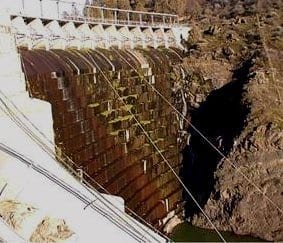Thirty Seconds To Better Steelhead & Salmon Fishing in California (and a Stronger Economy)
The facts are clear: The four lower Klamath River dams (which are currently throttling the salmon and steelhead populations on what used to be the west coast’s third-most productive salmon fishery) are not only bad for fish, they’re bad for California’s economy (if updated instead of removed, they’d run at a $20 million annual loss).

Copco dam has outlived its usefulness -- and would even run at a $20 million loss...
And in literally thirty seconds, you can help us take them out.
Simply click here and offer a public comment supporting Alternative 2 (Full Dam Removal) of the Klamath Draft EIS/EIR.
While a supporting comment in your own words is always helpful, we’ve already written a sample comment which you can simply cut and paste into the very simple comment form (sample comment and picture of the form included below).
For an executive summary of the Draft EIS/EIR, click here.
For more information about the Klamath River Basin Restoration Agreement (KBRA) and other Klamath Issues, click here.
CalTrout is committed to working on this issue — expect to see more emails, articles and Trout Clouts on this important fight.
Click here to comment — and help restore California’s steelhead and salmon populations.
##### Sample Comment #####
Subject: Klamath Draft EIS/EIR: I support Alternative 2
Comment: I support Alternative 2 of the Klamath Draft EIS/EIR proposal (full removal of the Iron Gate, Copco1, Copco2, and J.C. Boyle dams).
- These dams are decimating one of the west’s most prolific salmon and steelhead fisheries and strangling the area’s economy
- Alternative 2 will help restore salmon runs (dramatically increasing steelhead populations), and ensure predictable water deliveries to irrigators
- The dams don’t make economic sense: if upgraded to modern standards they’ll actually operate at a $20 million annual loss
- Even the owner (PacifiCorp) wants these privately owned dams taken out
I support healthy fisheries and a healthy local economy (dam removal brings many jobs to the area) — and I support Alternative 2.
Thank you,
[your name]
Click here to comment — and help restore California’s steelhead and salmon populations.





2 Comments
What is the status of the removal of this dam and the restoration of the trout’s navigation route?
The KBRA/KHSA agreements (which would see the removal of four Klamath River dams) are still in force, but progress in a dysfunctional congress is slow.
We hope to report some good news soon.
Thanks for checking in.